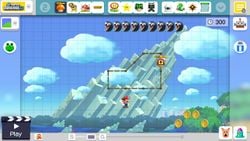Track

Tracks are objects found in many side-scrolling Mario games, debuting in Super Mario Bros. 3. They are paths drawn in the air on which objects - most commonly Lifts, but including other objects such as ? Blocks and enemies - travel. They can form closed loops, closed paths (where the object reverses direction on reaching the end) or open paths (where the object leaves the track to either fly onto another track or simply fall).
History
Tracks first appeared in World 1-6 of Super Mario Bros. 3, in which they are always found with a Lift connected to them, and unlike untracked Lifts, these ones move along the set path and only start moving once Mario or Luigi jumps on one. If the track has an endpoint, the Lift will go back the opposite direction once it reaches it. If there isn't one, the Lift will fall right off.
Starting from Super Mario World, enemies such as Fuzzies and Chainsaws started appearing on tracks, behaving similarly to Lifts.
Tracks can be also used as objects in Super Mario Maker. They can be produced in eight directions, and can be made into one-way paths when connected to each other as is, or loops when connected back to the start. If the player places an object on a track, it will move along the set path. The direction in which the object moves initially can also be set. On a non-looped path, once an object reaches the end, it will go back the other way; However, tapping on one of the two endpoints will make it disappear, causing any objects that reach the end to fall off the track instead. If the player shakes a track, it will make it rounded. Doors and large-scale objects such as platforms and Warp Pipes cannot be placed on tracks. Objects placed on tracks almost never interact with untracked objects, with the exception of Mario. For example, if a block or P-Switch that was placed on a track derails off of it, it won't collide with any outside object, but fall through them instead.